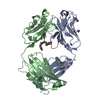[English] 日本語
 Yorodumi
Yorodumi- PDB-7n62: SARS-CoV-2 Spike (2P) in complex with C12C9 Fab (NTD local recons... -
+ Open data
Open data
- Basic information
Basic information
| Entry | Database: PDB / ID: 7n62 | ||||||
|---|---|---|---|---|---|---|---|
| Title | SARS-CoV-2 Spike (2P) in complex with C12C9 Fab (NTD local reconstruction) | ||||||
 Components Components |
| ||||||
 Keywords Keywords | VIRAL PROTEIN/Immune System / coronavirus / antibody / epitope / VIRAL PROTEIN / VIRAL PROTEIN-Immune System complex | ||||||
| Function / homology |  Function and homology information Function and homology informationMaturation of spike protein / viral translation / Translation of Structural Proteins / Virion Assembly and Release / host cell surface / host extracellular space / suppression by virus of host tetherin activity / Induction of Cell-Cell Fusion / structural constituent of virion / entry receptor-mediated virion attachment to host cell ...Maturation of spike protein / viral translation / Translation of Structural Proteins / Virion Assembly and Release / host cell surface / host extracellular space / suppression by virus of host tetherin activity / Induction of Cell-Cell Fusion / structural constituent of virion / entry receptor-mediated virion attachment to host cell / host cell endoplasmic reticulum-Golgi intermediate compartment membrane / receptor-mediated endocytosis of virus by host cell / membrane fusion / Attachment and Entry / positive regulation of viral entry into host cell / receptor-mediated virion attachment to host cell / receptor ligand activity / host cell surface receptor binding / symbiont-mediated suppression of host innate immune response / fusion of virus membrane with host plasma membrane / fusion of virus membrane with host endosome membrane / viral envelope / virion attachment to host cell / SARS-CoV-2 activates/modulates innate and adaptive immune responses / host cell plasma membrane / virion membrane / identical protein binding / membrane / plasma membrane Similarity search - Function | ||||||
| Biological species |   Homo sapiens (human) Homo sapiens (human) | ||||||
| Method | ELECTRON MICROSCOPY / single particle reconstruction / cryo EM / Resolution: 4 Å | ||||||
 Authors Authors | Windsor, I.W. / Jenni, S. / Bajic, G. / Tong, P. / Gautam, A.K. / Wesemann, D.R. / Harrison, S.C. | ||||||
 Citation Citation |  Journal: bioRxiv / Year: 2021 Journal: bioRxiv / Year: 2021Title: Memory B cell repertoire for recognition of evolving SARS-CoV-2 spike. Authors: Pei Tong / Avneesh Gautam / Ian Windsor / Meghan Travers / Yuezhou Chen / Nicholas Garcia / Noah B Whiteman / Lindsay G A McKay / Felipe J N Lelis / Shaghayegh Habibi / Yongfei Cai / Linda J ...Authors: Pei Tong / Avneesh Gautam / Ian Windsor / Meghan Travers / Yuezhou Chen / Nicholas Garcia / Noah B Whiteman / Lindsay G A McKay / Felipe J N Lelis / Shaghayegh Habibi / Yongfei Cai / Linda J Rennick / W Paul Duprex / Kevin R McCarthy / Christy L Lavine / Teng Zuo / Junrui Lin / Adam Zuiani / Jared Feldman / Elizabeth A MacDonald / Blake M Hauser / Anthony Griffths / Michael S Seaman / Aaron G Schmidt / Bing Chen / Donna Neuberg / Goran Bajic / Stephen C Harrison / Duane R Wesemann /  Abstract: Memory B cell reserves can generate protective antibodies against repeated SARS-CoV-2 infections, but with an unknown reach from original infection to antigenically drifted variants. We charted ...Memory B cell reserves can generate protective antibodies against repeated SARS-CoV-2 infections, but with an unknown reach from original infection to antigenically drifted variants. We charted memory B cell receptor-encoded monoclonal antibodies (mAbs) from 19 COVID-19 convalescent subjects against SARS-CoV-2 spike (S) and found 7 major mAb competition groups against epitopes recurrently targeted across individuals. Inclusion of published and newly determined structures of mAb-S complexes identified corresponding epitopic regions. Group assignment correlated with cross-CoV-reactivity breadth, neutralization potency, and convergent antibody signatures. mAbs that competed for binding the original S isolate bound differentially to S variants, suggesting the protective importance of otherwise-redundant recognition. The results furnish a global atlas of the S-specific memory B cell repertoire and illustrate properties conferring robustness against emerging SARS-CoV-2 variants. #1:  Journal: Cell(Cambridge,Mass.) / Year: 2021 Journal: Cell(Cambridge,Mass.) / Year: 2021Title: Memory B Cell Repertoire for Recognition of Evolving SARS-CoV-2 Spike Authors: Tong, P. / Gautam, A.K. / Windsor, I.W. / Bajic, G. / Harrison, S.C. / Wesemann, D.R. | ||||||
| History |
|
- Structure visualization
Structure visualization
| Movie |
 Movie viewer Movie viewer |
|---|---|
| Structure viewer | Molecule:  Molmil Molmil Jmol/JSmol Jmol/JSmol |
- Downloads & links
Downloads & links
- Download
Download
| PDBx/mmCIF format |  7n62.cif.gz 7n62.cif.gz | 157.1 KB | Display |  PDBx/mmCIF format PDBx/mmCIF format |
|---|---|---|---|---|
| PDB format |  pdb7n62.ent.gz pdb7n62.ent.gz | 115.6 KB | Display |  PDB format PDB format |
| PDBx/mmJSON format |  7n62.json.gz 7n62.json.gz | Tree view |  PDBx/mmJSON format PDBx/mmJSON format | |
| Others |  Other downloads Other downloads |
-Validation report
| Summary document |  7n62_validation.pdf.gz 7n62_validation.pdf.gz | 818.6 KB | Display |  wwPDB validaton report wwPDB validaton report |
|---|---|---|---|---|
| Full document |  7n62_full_validation.pdf.gz 7n62_full_validation.pdf.gz | 836.1 KB | Display | |
| Data in XML |  7n62_validation.xml.gz 7n62_validation.xml.gz | 28.6 KB | Display | |
| Data in CIF |  7n62_validation.cif.gz 7n62_validation.cif.gz | 41.1 KB | Display | |
| Arichive directory |  https://data.pdbj.org/pub/pdb/validation_reports/n6/7n62 https://data.pdbj.org/pub/pdb/validation_reports/n6/7n62 ftp://data.pdbj.org/pub/pdb/validation_reports/n6/7n62 ftp://data.pdbj.org/pub/pdb/validation_reports/n6/7n62 | HTTPS FTP |
-Related structure data
| Related structure data |  24192MC  7n64C M: map data used to model this data C: citing same article ( |
|---|---|
| Similar structure data |
- Links
Links
- Assembly
Assembly
| Deposited unit | 
|
|---|---|
| 1 |
|
- Components
Components
| #1: Protein | Mass: 141297.422 Da / Num. of mol.: 1 Source method: isolated from a genetically manipulated source Source: (gene. exp.)  Gene: S, 2 / Production host:  Homo sapiens (human) / References: UniProt: P0DTC2 Homo sapiens (human) / References: UniProt: P0DTC2 | ||
|---|---|---|---|
| #2: Antibody | Mass: 24556.465 Da / Num. of mol.: 1 Source method: isolated from a genetically manipulated source Source: (gene. exp.)  Homo sapiens (human) / Production host: Homo sapiens (human) / Production host:  Homo sapiens (human) Homo sapiens (human) | ||
| #3: Antibody | Mass: 23235.734 Da / Num. of mol.: 1 Source method: isolated from a genetically manipulated source Source: (gene. exp.)  Homo sapiens (human) / Production host: Homo sapiens (human) / Production host:  Homo sapiens (human) Homo sapiens (human) | ||
| #4: Sugar | ChemComp-NAG / Has ligand of interest | N | |
-Experimental details
-Experiment
| Experiment | Method: ELECTRON MICROSCOPY |
|---|---|
| EM experiment | Aggregation state: PARTICLE / 3D reconstruction method: single particle reconstruction |
- Sample preparation
Sample preparation
| Component | Name: SARS-CoV-2 Spike in complex with 12-C9 Fab / Type: COMPLEX Details: B cell receptor was sequenced from memory B cell of SARS-CoV-2 convalescent human patient and express as Fab. SARS-CoV2-2 surface protein (with 2P stabilizing mutations) was expressed as soluble ectodomain. Entity ID: #1-#3 / Source: RECOMBINANT | |||||||||||||||
|---|---|---|---|---|---|---|---|---|---|---|---|---|---|---|---|---|
| Molecular weight | Experimental value: NO | |||||||||||||||
| Source (natural) | Organism:  | |||||||||||||||
| Source (recombinant) | Organism:  Homo sapiens (human) / Strain: expi293F / Cell: human embryonic kidney / Plasmid: pVRC Homo sapiens (human) / Strain: expi293F / Cell: human embryonic kidney / Plasmid: pVRC | |||||||||||||||
| Buffer solution | pH: 7.5 | |||||||||||||||
| Buffer component |
| |||||||||||||||
| Specimen | Conc.: 1.2 mg/ml / Embedding applied: NO / Shadowing applied: NO / Staining applied: NO / Vitrification applied: YES | |||||||||||||||
| Specimen support | Grid material: COPPER / Grid mesh size: 400 divisions/in. / Grid type: C-flat-1.2/1.3 | |||||||||||||||
| Vitrification | Instrument: GATAN CRYOPLUNGE 3 / Cryogen name: ETHANE / Humidity: 88 % / Chamber temperature: 298 K |
- Electron microscopy imaging
Electron microscopy imaging
| Experimental equipment |  Model: Titan Krios / Image courtesy: FEI Company |
|---|---|
| Microscopy | Model: FEI TITAN KRIOS |
| Electron gun | Electron source:  FIELD EMISSION GUN / Accelerating voltage: 300 kV / Illumination mode: FLOOD BEAM FIELD EMISSION GUN / Accelerating voltage: 300 kV / Illumination mode: FLOOD BEAM |
| Electron lens | Mode: BRIGHT FIELD / Nominal magnification: 105000 X / Nominal defocus max: -2500 nm / Nominal defocus min: -1200 nm / Cs: 2.7 mm / C2 aperture diameter: 50 µm / Alignment procedure: COMA FREE |
| Specimen holder | Cryogen: NITROGEN |
| Image recording | Average exposure time: 1.8 sec. / Electron dose: 54.97 e/Å2 / Film or detector model: GATAN K3 BIOQUANTUM (6k x 4k) |
- Processing
Processing
| Software |
| ||||||||||||||||||||||||||||||||||||||||
|---|---|---|---|---|---|---|---|---|---|---|---|---|---|---|---|---|---|---|---|---|---|---|---|---|---|---|---|---|---|---|---|---|---|---|---|---|---|---|---|---|---|
| EM software |
| ||||||||||||||||||||||||||||||||||||||||
| CTF correction | Type: PHASE FLIPPING AND AMPLITUDE CORRECTION | ||||||||||||||||||||||||||||||||||||||||
| Particle selection | Num. of particles selected: 2842883 | ||||||||||||||||||||||||||||||||||||||||
| Symmetry | Point symmetry: C1 (asymmetric) | ||||||||||||||||||||||||||||||||||||||||
| 3D reconstruction | Resolution: 4 Å / Resolution method: FSC 0.143 CUT-OFF / Num. of particles: 147461 / Num. of class averages: 8 / Symmetry type: POINT | ||||||||||||||||||||||||||||||||||||||||
| Atomic model building | Space: REAL | ||||||||||||||||||||||||||||||||||||||||
| Atomic model building |
| ||||||||||||||||||||||||||||||||||||||||
| Refinement | Cross valid method: NONE Stereochemistry target values: GeoStd + Monomer Library + CDL v1.2 | ||||||||||||||||||||||||||||||||||||||||
| Displacement parameters | Biso mean: 141.24 Å2 | ||||||||||||||||||||||||||||||||||||||||
| Refine LS restraints |
|
 Movie
Movie Controller
Controller







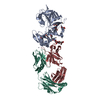
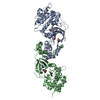




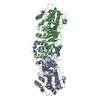
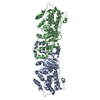



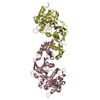
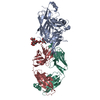
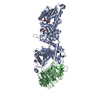
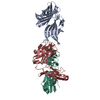
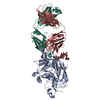

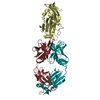

 PDBj
PDBj








